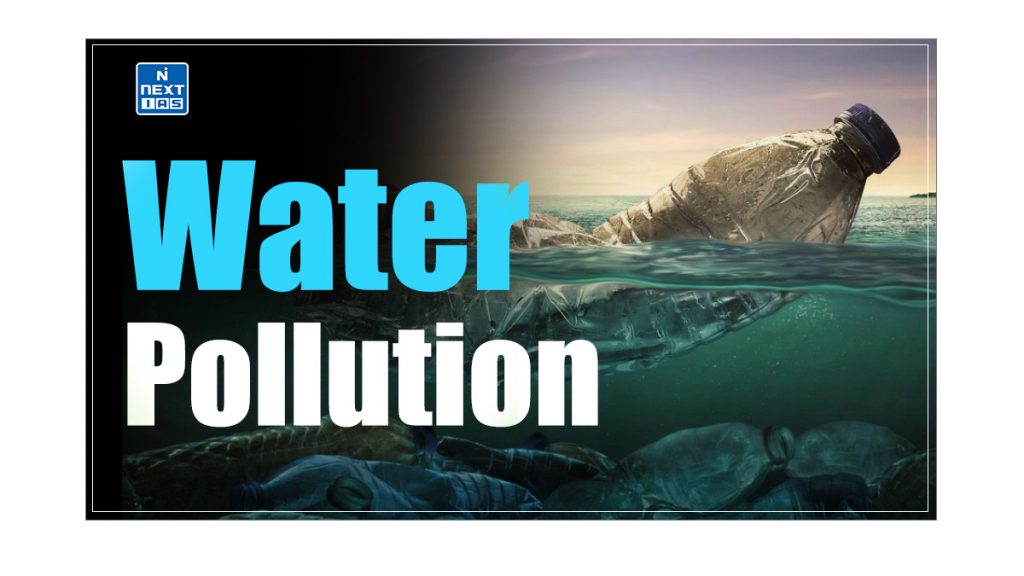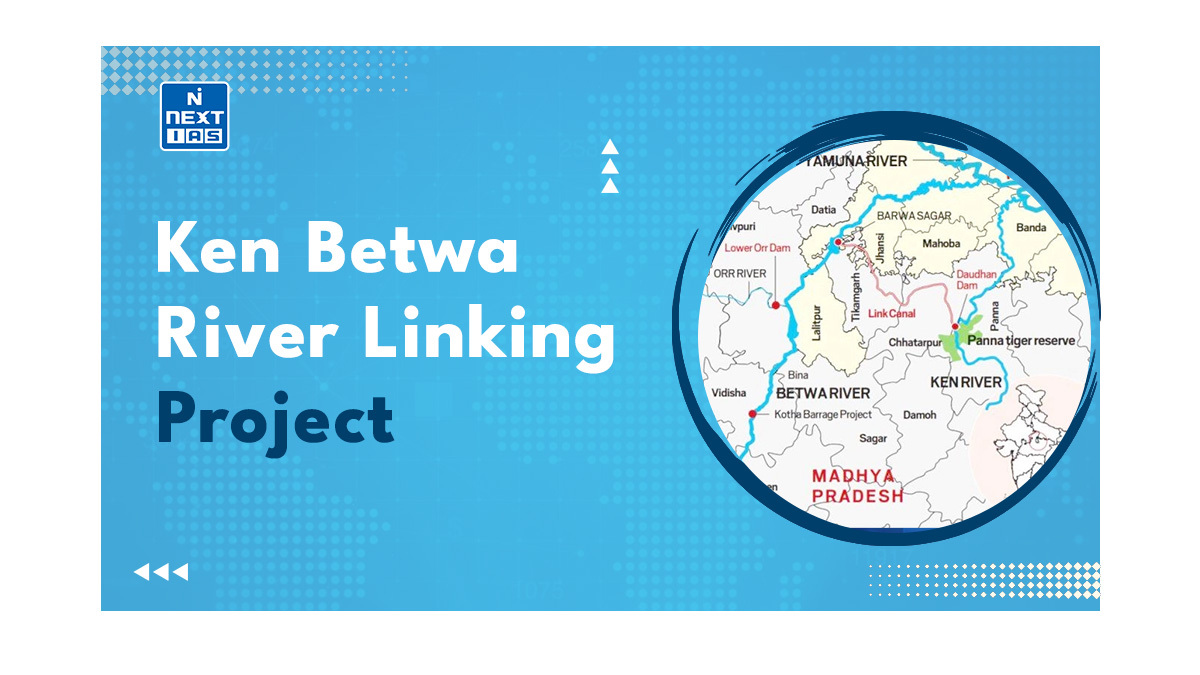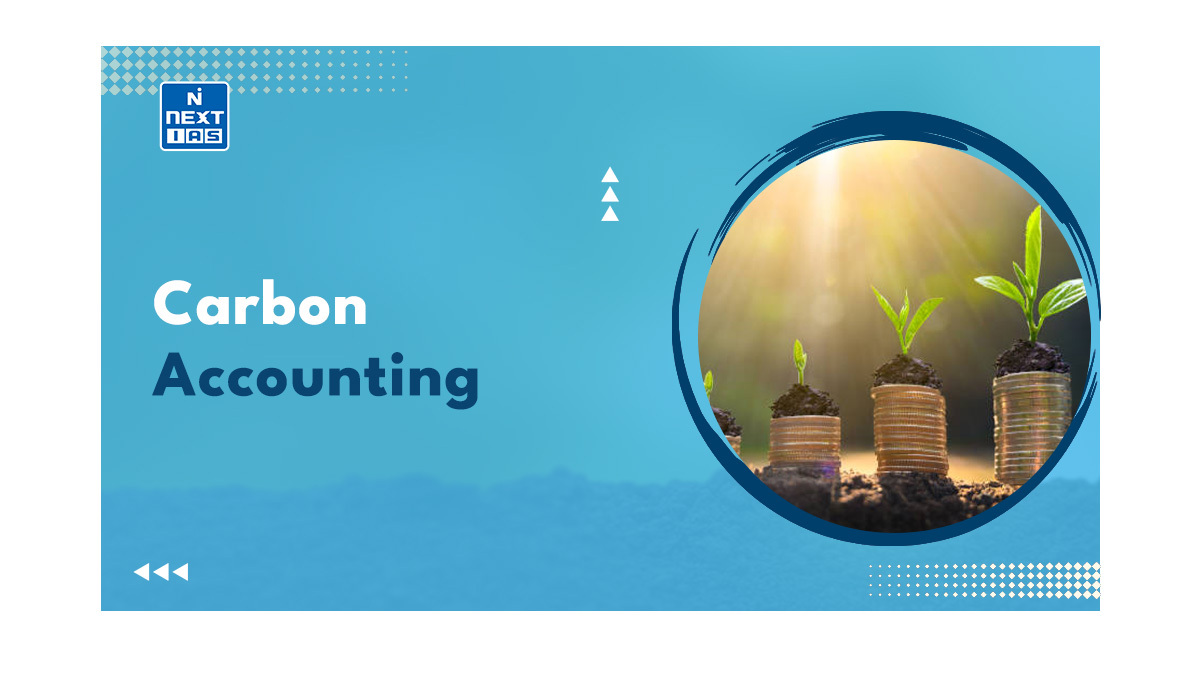
Water Pollution has emerged as a significant environmental challenge worldwide. It threatens public health, agriculture, and overall water security. This article aims to study water pollution in detail, including its meaning, major causes, sources, consequences, control measures, and other related aspects.
What is Water Pollution?
- Water Pollution is the contamination of water bodies such as lakes, rivers, streams, or marine environments caused by toxic substances discharged directly or indirectly into them without adequate treatment to remove harmful compounds.
- This spells disaster for aquatic ecosystems, and the pollutants also seep through and reach the groundwater, which might end up in our households as water used in daily activities.
- The contaminating substances that cause water pollution are called Water Pollutants.
- These substances can come from various sources, such as effluent discharge, solid waste, etc.
- Water Pollution is one of the prominent types of Environmental Pollution.
| What is Environmental Pollution? – Environmental Pollution refers to the introduction of harmful materials into the environment. – In other words, it is the contamination of the physical and biological components of the environment to such an extent that normal environmental processes are adversely affected. – Environmental pollution can be categorised into several types based on the nature of the pollutants and the media they affect, including Air Pollution, Soil Pollution, and Water Pollution. Read our detailed articles on Environmental Pollution, Soil Pollution, Air Pollution, Noise Pollution, Thermal Pollution, Nuclear Pollution, Marine Pollution, and Plastic Pollution. |
Sources of Water Pollution
Various sources of water pollution can be categorised into two types – Point Sources and Non-Point Sources.
Point Sources
- Pollution flowing from a single and identifiable source is termed as point source.
- For example, discharge pipe from a factory, roadway or leaking underground storage tank.

Non Point Sources
- Non-point sources of pollution are often termed ‘diffuse’ pollution, which refers to inputs and impacts that occur over a wide area and are not easily attributed to a single source.
- They are often associated with particular land uses instead of individual point source discharges.
- For example, run-off from agri fields, urban landscapes, mining fields, construction sites, etc.
- Non-point source pollution is often more difficult to control than point source pollution.

- The various non-point sources of water pollution are:
- Agriculture: In farming areas, non-point sources of pollution include pesticides, fertilisers, animal manure, and soil washed into streams during rainfall run-off, where stock is given access to stream banks. They may foul the water and accelerate erosion.
- Forestry Land Use: It may contribute to non-point source pollution of streams by increasing soil erosion and sediment run-off.
- Urban Land Use: Rainfall-runoff as stormwater drains is one of the major nonpoint sources of pollution in urban areas, impacting the water quality of our waterways and bays.
- Mining: Abandoned mine drainage is a form of water pollution.
- Highway and Bridges: Runoff from roads, highways, and bridges reach surface waters.
Types of Water Pollution
Based on different parameters, water pollutants can be classified into different categories, as described below:

Based on Origin
- Industrial Pollutants: Different industrial pollutants include carbonates, nitrites, and nitrates of heavy metals such as mercury, lead, zinc, arsenic, etc.
- Agricultural Pollutants: These are chemical fertilisers, pesticides, insecticides, herbicides, synthetic chemical compounds, weeds, and plant remains.
- Urban Pollutants: These contain chemicals from vehicular exhaust, lime, household sewage, chemical fertilisers used in the lawns and gardens within the city, etc.
- Natural Pollutants: The natural pollutants include volcanic dust, sediments due to weathering and erosion, debris caused by landslides, decayed and decomposed organic matter, etc.
Based on Physical and Chemical Characteristics
- Physical Pollutants: These pollutants can change physical characteristics such as taste, turbidity, colour, sedimentation content, dissolved and suspended solids, etc.
- Chemical Pollutants: Carbonates, chlorides, sulphites, sulphates, sulphides, nitrates of heavy metals like mercury, lead, cadmium, etc., pesticides, herbicides, insecticides and other chemical compounds.
- Biological Pollutants: Any contaminant of biological origin that causes water pollution is called a biological pollutant, such as infective bacteria, viruses, protozoa, and parasitic worms.
Based on Nature of Degradation
- Degradable Pollutants: Pollutants that can be broken down by biological agents such as decomposers or microorganisms.
- These are also known as organic pollutants, e.g. sewage, garbage, plants and animals.
- Non-Degradable Pollutants: These pollutants cannot be degraded quickly by biological agents or sunlight.
- These are also known as inorganic pollutants, e.g. plastic pollutants, solid toxic substances and chemical pollutants.
Causes of Water Pollution
- Water pollution is caused by various human activities that introduce harmful substances into water bodies.
- Major causes of water pollution include industrial waste discharge, agricultural runoff containing pesticides and fertilisers, untreated sewage, oil spills, and the dumping of plastic and other non-biodegradable waste.
- Additionally, mining activities, deforestation, and the improper disposal of hazardous chemicals contribute to water contamination as well as water pollution.
- This water pollution disrupts aquatic ecosystems, harms wildlife, and poses serious health risks to humans.
- Natural causes, such as volcanic eruptions and soil erosion, can also lead to water pollution, but human activities are the primary contributors.
Effects of Water Pollution
The effects of water pollution are as follows:
- Health Effects
- Contaminated water is a major source of waterborne diseases such as cholera, typhoid, hepatitis A, and dysentery.
- Exposure to toxic chemicals in polluted water can lead to serious health conditions, including cancers, neurological disorders, and reproductive issues.
- Environmental Effects
- Water pollution can disrupt reproductive processes, cause fish kills, and alter aquatic habitats.
- All these lead to the loss of biodiversity.
- Excess nutrients from agricultural runoff can cause eutrophication, leading to algal blooms that deplete oxygen levels in water.
- This process can result in “dead zones” where aquatic life cannot survive.
- Water pollution can disrupt reproductive processes, cause fish kills, and alter aquatic habitats.
- Economic Effects
- Water pollution can have significant economic costs, including increased healthcare expenses, loss of tourism revenue, and reduced agricultural productivity.
- Water pollution affects fish populations, reducing catches and economic losses for the fishing industry.
- Cleaning up polluted water bodies and restoring affected ecosystems can cause substantial costs.
- Other Effects
- Water Pollution can render freshwater sources unusable, reducing the availability of clean water for drinking, irrigation, and industrial use.
- This can exacerbate water scarcity issues.
- Water Pollution can render freshwater sources unusable, reducing the availability of clean water for drinking, irrigation, and industrial use.
Effects of Toxic Chemicals on Human Health
| Chemicals | Health Impacts |
|---|---|
| Mercury | Minamata Disease—Mercury is converted into Methyl Mercury by bacterial action, which causes numbness of limbs, lips, and tongue, deafness, blurring of vision, and mental derangement. |
| Cadmium | Itai-itai disease (ouch-ouch disease) – a painful disease of bones and joints.Cancer of the liver and lung |
| Nitrate | Methahaemoglobinemia or Blue-baby Syndrome – Nitrate reacts with haemoglobin and forms non-functional methaemoglobin that impairs Oxygen transport. |
| Fluoride | Skeletal fluorosis – hardened bones and stiff and painful joints.Teeth deformity |
| Arsenic | Black-Foot DiseaseDiarrhoeaPeripheral NeuritisHyperkeratosisLung and skin cancers |
| Lead | Symptoms of Lead exposure: persistent fatigue, irritability, loss of appetite, constipation, insomnia.Effects in Children: damage to brain and nervous system, behavioural problems, anaemia, liver and kidney damage, hearing loss, dev delays.Effects in Adults: poor muscle coordination, nerve damage, high BP, hearing and vision impairment, reproductive problems, and low fetal development. |
Treatment of Polluted Water
Treatment of Polluted Water involves the following three processes
Primary Treatment
It involves physical processes such as separating large debris, sedimentation in tanks, etc.
Secondary Treatment
- It involves biological processes, which are carried out by microorganisms.
- In this process, microbes oxidise the organic matter present in the polluted water.
Tertiary Treatment
- It involves physicochemical processes that remove turbidity in water caused by the presence of nutrients, organic matter, metal, or pathogens.
- The usual method in this process includes – the chemical oxidation of water by strong oxidising agents like Chlorine Gas, Perchlorate Salts, O3, and UV Radiation.
Suggested Measures to Tackle Water Pollution
The measures to tackle the water pollution can be seen as follows:
- Strengthening Environmental Regulations: Effective implementation and enforcement of laws such as the Water (Prevention and Control of Pollution) Act, 1974, and the Environment Protection Act, 1986, are crucial. Regulatory bodies like the Central Pollution Control Board (CPCB) and State Pollution Control Boards (SPCBs) must ensure compliance and take action against violators.
- Monitoring and Compliance: Regular water quality monitoring and strict compliance with discharge standards can help prevent and mitigate pollution.
- Advanced technologies and data analytics can be used for real-time monitoring and early pollution detection.
- Wastewater Treatment: Investing in modern wastewater treatment facilities is essential to reduce the discharge of pollutants into water bodies.
- Use of Biotechnology: With the help of biotechnology, we can engineer microorganisms to neutralise the harmful pollutant in water. E.g. oil zapper and oilivorous-s, etc.
- Sustainable Agriculture Practices: Promoting sustainable agriculture practices, such as organic farming and integrated pest management, can minimise the use of harmful chemicals and reduce agricultural runoff.
- Industrial Pollution Control: Implementing strict regulations and enforcement mechanisms to control industrial pollution can help prevent the discharge of harmful substances into water bodies.
- Solid Waste Management: Improving waste management practices, including proper disposal and recycling, can reduce the risk of pollution from landfills and dumpsites.
- Public Awareness and Education: It is crucial to raise public awareness about the importance of water conservation and the consequences of pollution.
- Educating communities about the proper use and management of water resources can foster a sense of responsibility and encourage sustainable practices.
Conclusion
Water Pollution is a multifaceted issue with significant implications for public health, ecosystems, and economic development. Addressing this challenge requires a comprehensive approach involving regulatory measures, technological innovations, sustainable practices, and public engagement. By promoting cleaner practices and investing in effective solutions, India and the world can work towards ensuring safe and sustainable water resources for future generations.
Dissolved Oxygen (DO)
- Dissolved Oxygen (DO) is the amount of Oxygen gas dissolved in a liquid, such as water.
- It is an essential component for aquatic life, as it is required for the respiration of fish, plants, and other organisms.
- The higher the water temperature, the lower the rate of O2 dissolution. Thus, the discharge of hot wastewater lowers the Dissolved Oxygen (DO) level.
Biological Oxygen Demand (BOD)
- Biological Oxygen Demand (BOD) refers to the amount of Oxygen required by aerobic decomposers for the biochemical degradation of biodegradable organic materials in water.
- The higher the Biological Oxygen Demand (BOD), the lower the Dissolved Oxygen (DO) level.
Chemical Oxygen Demand (COD)
- Chemical Oxygen Demand (COD) refers to the amount of Oxygen equivalent to the requirement for oxidation of total organic matter (biodegradable and non-biodegradable) present in water.
- The higher the Chemical Oxygen Demand (COD), the lower the Dissolved Oxygen (DO) level.
Frequently Asked Questions (FAQs)
What is Water Pollution?
Water pollution is the contamination of water bodies such as rivers, lakes, oceans, and groundwater by harmful substances, leading to the degradation of water quality and the disruption of aquatic ecosystems.
What are the causes of Water Pollution?
Water pollution is caused by industrial waste, agricultural runoff, untreated sewage, oil spills, and plastic waste. Other contributors include deforestation, mining, and the improper disposal of hazardous chemicals.
How to prevent Water Pollution?
To prevent water pollution, industries must treat waste before disposal, reduce plastic usage, promote sustainable farming practices, properly manage sewage, and encourage public awareness about reducing pollutants.
What are the effects of Water Pollution?
Water pollution leads to the destruction of aquatic ecosystems, kills marine life, contaminates drinking water, and spreads waterborne diseases. It also disrupts food chains, reduces biodiversity, and negatively impacts human health and livelihoods.






